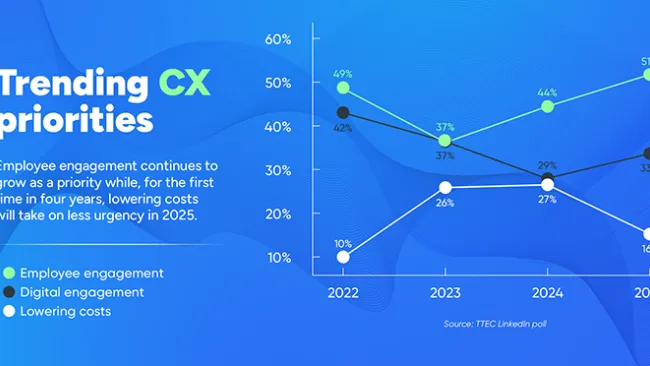When most customer care leaders think of at-home workers, they think of temporary, seasonal staff brought in for a quick fix, who are then discarded until next season. However, this mindset is changing. Labor challenges, volatile weather, and the desire to return to onshore operations are top-of-mind issues, positioning at-home as a feasible option for daily permanent operations.
Finding and keeping staff at a specific physical location is more of a challenge as wages rise and potential employees have more choices of where to work. The talent pool in a single geography can be a hindrance, especially if a large staff is needed Also, recent hurricanes, wildfires, floods, and other inclement weather conditions are causing more widespread damage and power outages, leaving physical centers vulnerable. These are just some of the reasons why companies are looking at the U.S. at-home associate model in a more thoughtful, cost-effective way.
Working from home is a growing trend in all industries. Gallup reported last year that 43 percent of employed Americans spend at least part of their time working remotely. As the model gets more pervasive, the business case continues to be proven in multiple industries. When companies are successful with an at-home model, many of their competitors are willing to give it a try.
We advocate for at-home associates to be a substantial part of a company’s associate mix, rather than a temporary seasonal solution. At-home associates tend to be older, experienced, and well-educated (see sidebar). They are at-home for a reason—often due to schedule, family, or mobility issues. And they have much higher retention and employee NPS scores than traditional associates, because their needs are being served with an at-home model.
As customer care gets more automated, the need for high-quality associates will only increase. The industry is expected to steadily grow for the next five years, according to JLL research, “accompanied by changes in multichannel delivery and services, and a digital shift in end-user experiences.” Simple interactions will be automated, leaving humans to instead focus on increasingly complex customer conversations. Companies will be more likely to find the best associates if they distribute their workforce, rather than stick to a specific geography.
Without geographical barriers, companies can more easily hire at-home associates with niche skills who understand complex issues, such as nursing or medical backgrounds for healthcare, or mechanics for car brands.
Or they can also find brand advocates and super-users. Streaming media company Hulu hired TV enthusiasts as part of its at-home workforce, according to Karen Van Kirk, vice president of Viewer Experience. She told a recent Forrester conference audience that they help “blur the line between service and engagement” by discussing shows with customers and one another.
In our work with clients, we have identified a number of operational and employee best practices for making the move to an at-home model successful.
Operational Best Practices
1. Keep at-home associates at home
Often we see companies dip their toe into the at-home model with a hybrid, hub-and-spoke model. This means associates work at home most of the time, but come into the center once in a while to meet with supervisors and connect with peers.
This approach improves the likelihood of buy-in from executives skeptical about a completely at-home model. But it often fails because it eliminates all of the advantages of at-home associates.
The at-home workforce is at home for a reason. They don’t want to go into a center (and sometimes they physically can’t). They want a flexible schedule or they may live too far from the physical center. Companies who deploy a hub-and-spoke model end up hiring the same types of people who work in the physical centers. If that’s the case, there is no reason to spend the resources setting up at-home options.
Instead, commit to home-based associates. Be discerning in your hiring practices to find the highest-quality at-home employees to serve the needs of your customers. Spread the hiring net wide to reach the best candidates, who you trust and will enjoy the work and want to stay.
2. Get your knowledgebase in order
Too often, operational knowledge and information is disparate and uncoordinated. There may be tribal knowledge of how to do things, with a few long-term employees serving as experts to go to when an issue comes up. There may be binders of information, spreadsheets, or other non-integrated information stacked on shelves around the office. Processes are informal and procedures are loose. This may work in a physical center where people can search and ask around, but it won’t translate to an at-home model.
If you don’t have good documentation of what to do or poor processes and procedures, you are more vulnerable in the at-home environment. Informal information and processes are hard to replicate at scale with individual, at-home employees.
Before hiring at-home workers, be sure your processes, procedures, and knowledge base are centralized, updated, and easily accessible. If possible, define common customer journeys and document how best to optimize them. Then continuously gather voice-of-the-customer and voice-of-the-employee insight and make updates to keep it fresh.
3. Lock down security
Security fears are a leading deterrent of the at-home model. Technology and human oversight have come a long way in this regard to alleviate those fears. Webcams and screen monitors keep an eye on remote associates, and many at-home programs include regular screen and voice audits to spot-check associate activity. Hiring has also changed to include background checks and personality assessments to judge associate trustworthiness before they start taking live calls and accessing real data.
In some industries, security and process must be even further scrutinized. Healthcare is bound by strict HIPAA and other compliance measures, for example, and financial services also have many more checks and balances specific to industry regulations.
It’s critical that any potential partners have a deep understanding of the unique security aspects of your industry and can prepare at-home associates to be even more secure than on-premises employees.
4. Go digital
Digital interactions like chat, email, and in-app messaging are growing. Customers prefer their quick and efficient nature, and they are less expensive and more streamlined on the business side. Unlike voice calls, chat and email interactions work best when staffed by native English speakers with advanced skills, making them perfect channels for at-home workers. This option is also a good way to overcome the concern that some executives have in terms of potential for inappropriate background noise like dogs barking.
Employee Best Practices
1. Online enthusiasts welcome
At-home associates must be comfortable living online. Most of their interactions with colleagues and customers will be via chat, discussion forums, and other online tools. Even those who work in the voice channel will likely use online tools for workforce management, meetings, and other business interactions.
Associates who feel supported and part of the corporate community will remain in their roles longer and are more likely to succeed. As much as possible, extend on-premises fun and engagement activities to at-home associates online. Have a dedicated team to ensure everything happening in the centers can be applied to at-home associates. Send them materials that go on the contact center walls. Let them ring the bell or be notified when something good happens in the center. Enable video meetings, regular coaching sessions, and collaborative forums so associates can better connect with colleagues both professionally and personally. Proactive employee outreach will keep culture and morale high, even for associates sitting miles away.
2. Keep seasonal Associates “warm” all year
The trend to use at-home work began as a way to fill in seasonal spikes in volume. When the need was finished, so was the associate until the following season. While seasonal work is still a natural fit for at-home, why not use these high-value associates throughout the seasons?
Once they’re in, keep them engaged all year with different types of work. The healthcare sector is inundated at the end of the year during open enrollment, while financial services companies see volume spikes around tax time, and travel companies are busiest during the summer. Even within the same company, there are other areas of the business that could use a hand outside of a narrow contact center definition.
A steady schedule will help attract and retain the best associates, and save talent acquisition and training costs over the long term. Hire associates who can manage multiple industries and who can transition into helping different types of customers.
3. Plan on part-time
As mentioned previously, at-home associates are at home for a reason. A part-time schedule is much more in line with their expectations. In addition, we’ve found that associates working solo for more than 30 hours per week are more likely to have lower morale and dissatisfaction than if they work a little less. Our recommendation is to staff associates between 16 and 28 hours per week. This gives them the flexibility of a strong resource investment.
Besides the number of hours, at-home workers are more amenable to off-hours work. While a day shift schedule is preferred on-premises, at-home associates are more comfortable with working around their schedule—early mornings, evenings, and weekends. This allows companies to get creative with scheduling and provide a much more consistent speed to answer throughout the day, which increases the end customer experience. It also will lift both phone and in-chair occupancy by interval driving down the cost per call at the enterprise level. These part-time associates can help fill in during shortages or undesirable times for physical center associates who prefer to stick to a more routine schedule, which can lift brick-and-mortar staff retention and absenteeism.
These are just some ways to enable an optimum at-home workforce that satisfies customers and meets today’s changing business needs. The move to at-home need not be done all at once. For traditional companies, we recommend about a 20 percent at-home model to mix with your on-premises workforce. Start small with a pilot or distinct group, and roll out more as you go.
Contact centers will not go away entirely, but the days of the cookie-cutter “butts-in-seats” approach won’t last. Combining at-home associates adds quality, flexibility, and reduces risk in care operations on-premises.
















